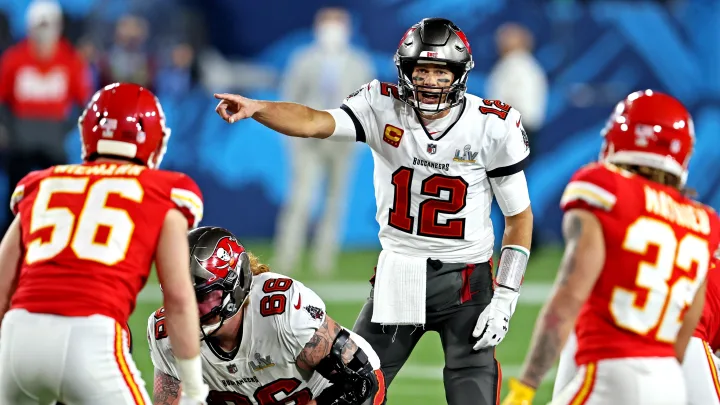Explaining the football point spread can help bettors win more often.
Key Points
– Betting against the point spread is the most popular of all football bets.
– Understanding everything about point spreads is the first step to betting success.

The Football Point Spread
Understanding as much as possible about the football point spread is a key to winning more NFL and college football bets. In the world of sports betting, betting on football – both pro and college – is king. Betting on the point spread is the king of all bet types. We’re here to help you prepare for betting football.
Each week, oddsmakers set point spreads for numerous games in both the NCAA and NFL. This makes even what seem like one-sided games much more interesting.
Betting on these games can be tricky, but understanding all there is to know about point spreads can help any bettor have success. Follow along as we help you learn to read spreads and offer some tips and strategies for betting them.
Point Spread Definition
Oddsmakers calculate the perceived differences between two teams using mathematical formulas. They add in external factors such as weather, playing at home or on the road, injuries, and more. In the end, they use the point spread to level the playing field between the two teams.
The stronger of the two teams is the favorite. The favorite is designated by the minus sign (-) in front of the point value. For example, Dallas is a three-point favorite over Washington. At a sportsbook, you would see the bet displayed like this:
Dallas Cowboys -3 (-110)
Washington Commanders +3 (-110)
It is more common for college football point spreads to be double-digit numbers. In the NFL, there are only 32 teams and the difference between the best and worst teams is not as great as it is at the college level. You might see a college game like this one:
Alabama Crimson Tide -53.5 (-110)
Mercer Bulldogs +53.5 (-110)
How Are Point Spreads Calculated
For oddsmakers at sportsbooks, the setting of a point spread is usually a three-step process. It begins long before a season begins. For sportsbooks using pay per head software, the process is even easier.
Oddsmakers begin building mathematical ratings for every team in the NFL and NCAA FBS. They continue to tweak these ratings as a season wears on. These ratings, as well as a number of other factors, will figure into a given point spread during a season.
These other factors include things like playing at home, rest, injuries, and even coaching strategies. All of these factors are translated into an opening point spread for a game.
As bets begin to come in, the point spread can still be influenced by any number of factors. A practice injury, for example, would affect the point spread. The point spread is also affected by the bets coming in.
Remember, a sportsbook would like to bring in an equal amount on either side of a bet. When point spreads adjust during the week, most other sportsbooks will follow. Many sportsbooks don’t even create their own lines. They simply follow the market. Be aware of that.
EDITOR’S CHOICE: NFL PLAYER PROP BETTING MARKETS
Winning Point Spread Bets
In order to “cover the spread,” here’s how it works. Using the above examples, let’s say a bettor wagers on Dallas. In order to win the bet, the Cowboys must win by four or more points. If Dallas wins 28-21, the “cover” and Cowboys’ bettors win.
On the other end of the bet, let’s say a bettor wagers on Mercer to cover. If Alabama wins 53-0, they do not cover the spread and Mercer bettors win.
Underdogs can also win by winning their game outright. Go back to the Cowboys’ example. If Washington wins the game, anyone betting on the underdog wins. The Commanders either have to lose by two or fewer points or win outright.
It’s also worth mentioning the -110 in parentheses. Those are the odds on the bet. Most bets will open with a standard -110. This is essentially the price for a sportsbook to take the bet. In order to win $1.00, the bettor must wager $1.10. Should the sportsbook have to pay out the $1.00, it keeps the $0.10 as its commission. That commission is also known as “juice.”
Remember, sportsbooks are in business to make money. They will adjust odds on point spread bets in order to encourage or discourage bettors on either side of the bet. Ultimately, the book wants to bring in an equal amount of wagers on both sides of a bet.
Key Numbers
Scoring in football is very rigid and happens in factors of either 3, 6, or 7. If you think about it, the number of games that end in factors of these numbers is pretty large.
For example, the most common scoring margin in an NFL game is 3. The next most common scoring margins are 6 and 7. Roughly 10 to 12 percent of all NFL games end with a scoring margin of 3, 6, or 7 points.
Because of these key numbers, NFL point spreads are usually set at 2.5, 3, 3.5, 6, 6.5, 7, and 7.5. Understanding these key numbers can help bettors win more often against the spread. It pays to find an underdog that you like at +3.5 instead of +3 since more games end with a margin of 3 points instead of 4.
It also helps knowing that NFL rules changes affect the extra point. Kickers now make only 93 percent of their extra points compared to 99 percent before a rule change in 2015. That means there is now more value on a favorite at -6.5 or an underdog at +7.5.
The bottom line for any NFL point spread bettor is this. Understanding as much as possible about point spreads will help you win more bets.





